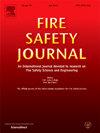在英国报告火灾死亡或严重事件,其中润肤剂被记录为一个促成因素
IF 3.4
3区 工程技术
Q2 ENGINEERING, CIVIL
引用次数: 0
摘要
据英国药品和保健产品监管局(MHRA)记录,2010年至2018年期间,有53人死于火灾,据报道,火灾涉及受润肤剂污染的织物。然而,人们普遍认为这类事件被低估了,因为人们对润肤剂污染导致的火灾风险增加的认识和理解存在问题。因此,信息自由(FOI)要求被用于评估英国消防和救援服务(FRS)的报告。52个国家中有47个作出了答复,其中23个国家没有记录有使用润肤剂的火灾死亡或严重事件。从2015年到2022年,24份答复详细记录了78起死亡和6起严重事件,这是以前记录的每年的两倍。这可能表明在2018年至2022年期间,人们对润肤剂使用的认识和报告有所提高。与政府火灾统计数据的比较表明,英国22%的火灾死亡可能涉及含有润肤剂残留物的服装/纺织品,因为该物品首先被点燃。结果表明,记录此类事件的主要问题是,84个事件中只有3个进入了英国MHRA黄卡计划。研究结果强调了与润肤剂相关的严重火灾风险,以及提高预防建议和意识的必要性。本文章由计算机程序翻译,如有差异,请以英文原文为准。
Reporting of fire deaths or serious incidents in the UK where emollients are recorded to be a contributing factor
The UK Medicine and Healthcare products Regulatory Agency (MHRA) recorded 53 deaths between 2010 and 2018 in fires where the involvement of emollient contaminated fabrics was reported. However, such incidents are widely accepted to be underreported, with problems in awareness and understanding of the increased fire risk resulting from emollient contamination. Therefore, a Freedom of Information (FOI) request was used to evaluate reporting by UK Fire and Rescue Services (FRS). 47 out of 52 responded, with 23 having no fire deaths or serious incidents where the use of emollients was documented. From 2015 to 2022, 78 deaths and 6 serious incidents were detailed in 24 responses, this was double per year than recorded previously. This may indicate improvements in awareness and therefore reporting of emollient use between 2018 and 2022. Comparison with government fire statistics indicate the possibility of 22 % of fire deaths in GB involving clothing/textile containing emollient residue as the item first ignited. Results indicate a major problem with documenting such incidents with only 3 of the 84 entered on the UK MHRA yellow card scheme. The results highlight the serious fire risk associated with emollients and the need for improved prevention advice and awareness.
求助全文
通过发布文献求助,成功后即可免费获取论文全文。
去求助
来源期刊

Fire Safety Journal
工程技术-材料科学:综合
CiteScore
5.70
自引率
9.70%
发文量
153
审稿时长
60 days
期刊介绍:
Fire Safety Journal is the leading publication dealing with all aspects of fire safety engineering. Its scope is purposefully wide, as it is deemed important to encourage papers from all sources within this multidisciplinary subject, thus providing a forum for its further development as a distinct engineering discipline. This is an essential step towards gaining a status equal to that enjoyed by the other engineering disciplines.
 求助内容:
求助内容: 应助结果提醒方式:
应助结果提醒方式:


